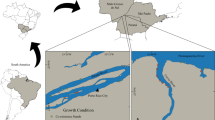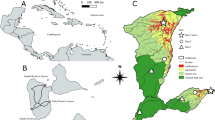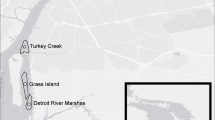Abstract
Purple loosestrife (Lythrum salicaria) is an invasive wetland perennial that is thought to threaten the ecological integrity of North American wetlands by forming monotypic stands and altering the diversity of native wetland ecosystems. To determine if purple loosestrife infestation alters aquatic invertebrate communities, the abundance and size distribution of aquatic invertebrates associated with purple loosestrife were quantified during the spring and summer and compared to those within stands of two other commonly occurring emergents, cattail (Typha latifolia) and bulrush (Scirpus acutus). Aquatic invertebrates representing 10 taxa (classes or orders) were collected using four different sampling techniques. Individuals from each taxa were collected in all three vegetation types, although the size of the individuals of some orders was smaller in Lythrum. Measurements of water quality indicated no significant (p<0.05) differences among the three vegetation types, despite the fact that Scirpus tended to be established in deeper water than Lythrum. Results indicate that monotypic stands of purple loosestrife are not lacking in aquatic invertebrates; however, because our study was conducted in a mixed vegetation wetland at an intermediate stage of purple loosestrife infestation, our findings may not be representative of more extreme purple loosestrife invasions.
Similar content being viewed by others
Literature Cited
Arroll, S. G., C. E. Grue, C. J. Perry, and G. L. Piper. 1994. Potential impacts of purple loosestrife and its control on wetlands in Washington State: An evaluation of research needs. Lake and Reservoir Management 9:171–174.
Balogh, G. R. 1986. Distribution and seedling ecology of purple loosestrife in Ohio’s Lake Erie marshes. Ohio Journal of Science 86:51.
Balogh, G. R. and T. A. Bookhout. 1989. Purple loosestrife (Lythrum salicaria) in Ohio’s Lake Erie Marshes. Ohio Journal of Science 89:62–64.
Beckett, D. C. and T. P. Aartila. 1990. contrasts in density of benthic invertebrates between macrophyte beds and open littoral patches in Eau Galle Lake, Wisconsin. American Midland Naturalist 127:77–90.
Blossey B. and R. Notzold. 1995. Evolution of increased competitive ability in invasive non indigenous plants: a hypothesis. Journal of Ecology 83:887–889.
Blossey B., D. Schroder, S. D. Hight, and R. A. Malecki. 1994. Host specificity and environmental impact of the weevil Hylobius transversovittatus, a biological control agent of purple loosestife (Lythrum salicaria). Weed Science 42:128–133.
Brown, A. L. 1971. Ecology of Freshwater. Harvard University Press, Cambridge, MA, USA.
Crowder, L. B. and W. E. Cooper. 1982. Habitat structural complexity and the interaction between bluegills and their prey. Ecology 63:1802–1813.
de Szalay, F. A. and V. H. Resh. 1996. Spatial and temporal variability of trophic relationships among aquatic macroinvertebrates in a seasonal marsh. Wetlands 16:458–466.
Dvorak, J. 1987. Production-ecological relationships between aquatic vascular plants and invertebrates in shallow waters and wetlands-a review. Archives of Hydrobiologia 27:181–184.
Dvorak, J. 1996. An example of relationships between macrophytes, macroin vertebrates and their food resources in a shallow eutrophic lake. Hydrobiologia 339:27–36.
Galatowitsch, S. M., N. O. Anderson, and P. D. Ascher. 1999. Invasiveness in wetland plants in temperate North America. Wetlands 19:733–755.
Hager, H. A. and K. D. McCoy. 1998. The implications of accepting untested hypotheses: a review of the effects of purple loosestrife (Lythrum salicaria) in North America. Biodiversity and Conservation 7:1069–1079.
Keddy, P. A. and P. Constabel. 1986. Germination of ten shoreline plants in relation to seed, soil particle size and water level: an experimental study. Journal of Ecology 74:133–141.
Major, W., III, M. J. Grassley, C. E. Grue, and S. C. Gardner. 1999. A vacuum water pump/filtration sampler for the collection of aquatic invertebrates. Journal of Freshwater Ecology 13:369–363.
Mal, T. K., J. Lovett-Doust, L. Lovett-Doust, and G. A. Mulligan. 1992. The biology of Canadian weeds. 100. Lythrum salicaria. Canadian Journal of Plant Science 72:1305–1330.
Mal, T. K., J. Lovett Doust, and L. Lovett Doust. 1997. Time-dependent competitive displacement of Typha angustifolia by Lythrum salicaria. Oikos 79:26–33.
Malecki, R. A., B. Blossey, S. D. Hight, D. Schroeder, L. T. Kok, and J. R. Coulson. 1993. Biological control of purple loosestrife. Bioscience 43:680–686.
Marshall, E. J. P. and D. F. Westlake. 1978. Recent studies on the role of aquatic macrophytes in their ecosystem. Proceedings of the Fifth International Symposium on Aquatic Weeds 43–51.
Mitich, L. W. 1999. Purple loosestrife, Lythrum salicaria L. Weed Technology 13:843–846.
Mittelbach, G. G. 1981. Patterns of invertebrate size and abundance in aquatic habitats. Canadian Journal of Fish Aquatic Science 38: 896–904.
Mittelbach, G. G. 1988. Competition among refuging sunfishes and effects of fish density on littoral zone invertebrates. Ecology 69: 614–623.
Mullin, B. H. 1998. The biology and management of purple loosestrife (Lythrum salicaria). Weed Technology 12:397–401.
Nelson, S. M., R. A. Roline, J. S. Thullen, J. J. Sartoris, and J. E. Boutwell. 2000. Invertebrate assemblages and trace element bioaccumulation associated with constructed wetlands. Wetlands 20: 406–415.
Oertli, B. 1995. Spatial and temporal distribution of the zoobenthos community in a woodland pond (Switzerland). Hydrobiologia 300–301:195–204.
Parsons, J. K. 1995. Analysis of the associations between macroinvertebrates and macrophytes in a freshwater pond. Northwest Science 69:265–275.
Piper, G. L. 1996. Biological control of the wetlands weed purple loosestrife (Lythrum salicaria) in the Pacific northwestern United States. Hydrobiologia 340:291–294.
Rawinski, T. J. and R. A. Malecki. 1984. Ecological relationships among purple loosestrife, cattail and wildlife at the Montezuma National Wildlife Refuge. N.Y. Fish Game Journal 31:81–87.
Reddy, K. R., P. D. Sacco, D. A. Graetz, K. L. Campbell, and K. M. Portier. 1983. Effects of aquatic macrophytes on physio-chemical parameters of agricultural drainage water. Journal of Aquatic Plant Management 21:1–7.
Saville, D. J. 1990. Multiple comparison procedures: the practical solution. American Statistician 44:174–180.
Scheffer, M., A. A. Achterberg, and B. Beltman. 1984. Distribution of macro-invertebrates in a ditch in relation to the vegetation. Freshwater Biology 14:367–370.
Schramm, Jr., H. L. and K. J. Jirka. 1989. Effects of aquatic macrophytes on benthic macroinvertebrates in two Florida lakes. Journal of Freshwater Ecology 5:1–12.
Shamsi, S. R. A. and F. H. Whitehead. 1974. Comparative ecophysiology of Epilobium hirsutum L. and Lythrum salicaria L. I. General biology, distribution and germination. Journal of Ecology 62:279–290.
Shamsi, S. R. A. and F. H. Whitehead. 1977. Comparative Ecophysiology of Epilobium hirsutum L. and Lythrum salicaria L. 3. Mineral nutrition. Journal of Ecology 65:55–70.
Stuckey, R. L. 1980. Distributional history of Lythrum salicaria (purple loosestrife) in North America. Bartonia 47:3–20.
Swanson, G. 1978. Funnel trap for collecting littoral aquatic invertebrates. Progressive Fish Culturist 40:73.
Templer, P., S. Findlay, and C. Wigand. 1998. Sediment chemistry associated with native and non-native emergent macrophytes of a Hudson River marsh ecosystem. Wetlands 18:70–78.
Thompson, D. Q., R. L. Stuckey, and E. B. Thompson. 1987. Spread, impact and control of purple loosestrife (Lythrum salicaria) in North American wetlands. U.S. Fish and Wildlife Service, Washington, DC, USA. Fish and Wildlife Research Report No. 2.
Thorp, J. H. and A. P. Covich. 1991. Ecology and Classification of North American Freshwater Invertebrates. Academic Press. Inc. New York, NY, USA.
Thorp, A. G. 1997. A comparison of water-column macroinvertebrates communities in beds of differing submersed aquatic vegetation in the tidal freshwater Potomac River. Estuaries 20:86–95.
Treberg, M. A. and B. C. Husband. 1999. Relationship between the abundance of Lythrum salicaria (purple loosestrife) and plant species richness along the Bar River, Canada. Wetlands 19:118–125.
Watkins, II, C. E., J. V. Shireman, and W. T. Haller. 1983. The influence of aquatic vegetation upon zooplankton and benthic macroinvertebrates in Orange Lake, Florida. Journal of Aquatic Plant Management 21:78–83.
Weihe, P. E. and R. K. Neely. 1997. The effects of shading on competition between purple loosestrife and broad-leaved cattail. Aquatic Botany 59:127–138.
Welling, C. H. and R. L. Becker. 1990. Seed bank dynamics of Lythrum salicaria L.: Implications for control of this species in North America. Aquatic Botany 38:303–309.
Werner, E. E. and D. J. Hall. 1974. Optimal foraging and the size selection of prey by the bluegill sunfish (Lepomis macrochirus) Ecology 55:1042–1052.
Wilcox, D. A. 1989. Migration and control of purple loosestrife (Lythrum salicaria L) along highway corridors. Environmental Management 13:365–370.
Author information
Authors and Affiliations
Corresponding author
Rights and permissions
About this article
Cite this article
Gardner, S.C., Grue, C.E., Major, W.W. et al. Aquatic invertebrate communities associated with purple loosestrife (Lythrum salicaria), cattail (Typha latifolia), and bulrush (Scirpus acutus) in central Washington, USA. Wetlands 21, 593–601 (2001). https://doi.org/10.1672/0277-5212(2001)021[0593:AICAWP]2.0.CO;2
Received:
Revised:
Accepted:
Issue Date:
DOI: https://doi.org/10.1672/0277-5212(2001)021[0593:AICAWP]2.0.CO;2




